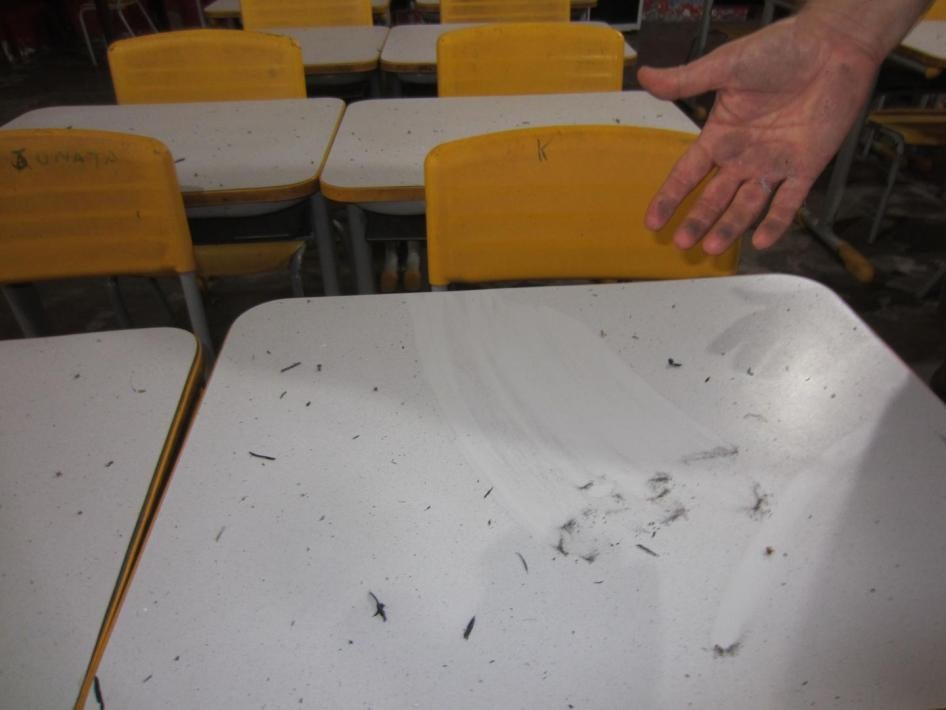A version of this op-ed was published in portuguese in O Globo on November 8, 2017.
Every morning, cleaners at the primary school in the small village of Piquiá de Baixo in northeastern Brazil wipe the desks and mop the classroom floor to clear the soot that’s accumulated overnight. But the fine black ash keeps on sprinkling down through the roof tiles during the day.
“Even though they clean it each day, students who study in the afternoon soon feel the soot on their desks and chairs,” said Maria (not her real name), a resident of Piquiá de Baixo who attended the primary school until fourth grade. “When I was a kid I thought this pollution was normal, but now I understand it shouldn’t be like that.”
Piquiá de Baixo is a community of about 300 families in a mostly rural area of Maranhão state. In the mid-1980s, an industrial complex of steel mills developed beside the village, some mills just 50 meters from people´s homes. The village sits on a train line that runs between the Carajás mine in the Amazon – the world’s largest iron-ore mine – and the port of São Luis, almost 900 kilometers away. Freight trains carrying iron ore stop on route to the port, so the ore can be processed into pig iron in the mills, the first step of steel manufacturing.
The expansion of the Brazilian mining and steel industry was a central plank of a federal government- supported development project in the Amazon in the 1980s. But as with so many other large-scale development projects, little thought was given to negative impacts on people’s rights.
What happens in Piquiá de Baixo matters to the rest of Brazil. Large development projects have led to environmental pollution in communities around the country – places like Santa Cruz in Rio de Janeiro and Ilha de Mare in Bahia. And other groups are already mapping and assessing some 100 toxic hotspots across the county that pose a threat to the health of children and families.
Maranhão’s environmental authority, which is mandated by law to control pollution, doesn’t regularly monitor the air, soil, or water in Piquiá de Baixo. But youth from the community have been recording air quality measurements on small hand-held devices since 2016. The results, which were published last month, were damming: readings of small particulate matter – a particularly dangerous form of air pollution because of its ability to penetrate deep into lungs and blood streams – were above the annual average maximum recommended by the World Health Organization, and on a number of days covered by the study, above the daily average maximum.
In 2016, health researchers from Italy’s National Cancer Institute reported that just under a third of the 220 residents they examined suffered from respiratory diseases. Researchers urged “urgent action to protect Piquiá de Baixo residents from the extremely high levels of pollution they are exposed to.”
These findings should come as no surprise. An environmental evaluation performed in 2007 at the request of the local court found that “emissions of soot, water containing metal residues and noise (in Piquiá de Baixo) are certainly harmful to human health” and recommended relocating the community.
Yet the authorities are not acting on these findings with the urgency they demand. Since 2008, the association of Piquiá de Baixo’s residents has pushed for relocating the community and developed detailed plans for houses, a new school, a health clinic, and other public services. Nearly 10 years later the residents are still waiting.
In 2015, the municipal government gave the association a title to new land about six kilometers from the present location to relocate the community. In May 2016, the federal government signed an agreement with the residents’ association to partially fund the construction of a new community under its social housing program “Minha Casa Minha Vida.”
But the proposal has stalled within the Ministry of Cities, awaiting formal approval of plans and the disbursement of funds. UN human rights experts wrote to the federal government in 2015 asking when resettlement will finally occur but have received no reply to date.
“Every day we stay here we are exposed to the same pollution,” Maria said. “This is a marginal neighborhood and the authorities have forgotten about us.”
Piquiá de Baixo holds plenty of potential lessons for government authorities as they confront similar problems across the country – about the importance of listening to local communities, of responding promptly to their demands, and ensuring that short-term economic growth does not come at the expense of people’s health.
The delays need to end. The federal government should fulfil its 2016 pledge to residents and clear the way for financial support for the new community under “Minha Casa Minha Vida.” And while waiting for the new community to be built, state environmental authorities should regularly monitor the ongoing pollution.
While the residents of Piquiá de Baixo have long demanded fresh air, they continue to breathe soot. Justice delayed is justice denied and the time for relocation is long overdue.
Richard Pearshouse is associate environment and human rights director at Human Rights Watch.










